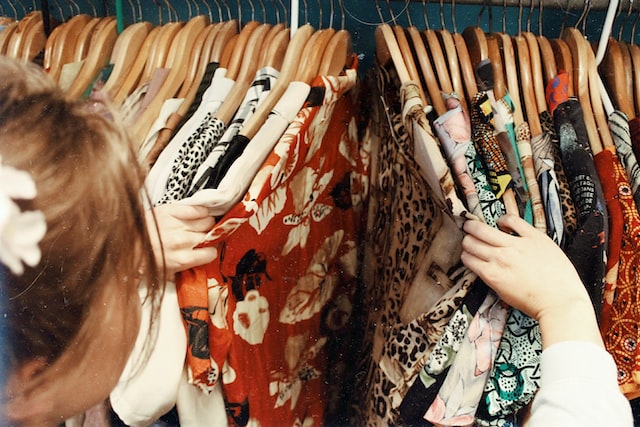Going organic may be not enough to stop fashion’s plastic problem
Buying less clothes might be as important as using natural cotton in reducing microplastic pollution from clothes
Kharishar Kahfi • September 23, 2022

Buying more durable clothes that can last for a decade can be an important first step to solve microplastic spillage from washing clothes, researchers suggest. [Credit: Becca McHaffie | Unsplash License]
Since 2016, the year when the U.S. made a record by generating up to 42 million tons of plastic, the world has begun to understand how microplastics pollute our ground and our water. And most microscopic materials come from a source that’s really close to our body: our clothes.
Ever since studies revealed the scale of microplastic pollution from fashion, the world has been scrambling to look for alternatives to plastic-infused clothes. But getting rid of plastic pollution from clothes isn’t as easy as it sounds. Replacing synthetic fabric with organic fibers sounds like a good way, but consumers might be discouraged from buying them as the natural fibers are sometimes inconvenient.
“Everybody wanted wrinkle-free, everybody wanted something which was convenient,” says Sonali Diddi, a sustainable clothing professor from Colorado State University.
Clothes are commonly wrinkled because of the heat during the drying process. Fabrics, like wool and nylon, have their own “glass transition temperature,” or a certain temperature limit where the material can maintain its molecular structure within the fiber. When the fiber gets exposed to temperatures above its glass transition threshold, the bond between the molecules breaks and changes the fiber’s shape. When the heat stops exposing the clothes, the new molecular structure stays in the form of wrinkles.
Synthetic fibers, such as nylon and spandex, are known for being resistant to wrinkles thanks to their inherent resilience. Aside from its convenience, synthetic fibers are also easy to produce. More than 100 billion pieces of clothing are produced globally every year — half of them are made from newly-created virgin plastics.
But they also shed more easily. Synthetic textiles are the largest primary microplastics source in the world’s oceans, contributing 35% of the total microplastics in the planet’s water, according to an estimate by the International Union for Conversation of Nature in 2017.
The microplastics find their way from clothes to the ocean during the laundry process. When synthetic clothes are washed in washing machines, they undergo mechanical and chemical stresses from the movement inside the washing tube as well as detergents and other laundry chemicals. The stresses cause microfibers to detach from the yarns of the textile. Water filter in the laundry machine and waste treatment plant can’t filter the microscopic fibers in the wastewater.
Scientists and the fashion industry have been looking for alternative materials that won’t pollute the water with plastics anymore. One alternative is synthetic-like fabric, made by partially breaking down cotton fibers by a technology startup Natural Fiber Welding. Another example is the “nuCycl” technology by textile startup Evrnu, which creates an engineered regenerative fiber that can be recycled to new products several times. And a final way is by going back to the basics, and embracing natural cotton materials as brands like Patagonia have increasingly been doing.
But these efforts are not enough. Most clothes produced and sold are still using synthetic fibers from plastics. Around 108 million metric tons of textile fibers were produced globally in 2020 according to a survey — three quarters of which, nearly 81 million, are chemical ones that include petroleum-based polymers. These fibers are still causing microplastic pollution when washed.
While it is important to push for changes in the industry, changing consumer’s behavior, such as buying fewer items and picking clothes made with natural fibers, can also be a key to reducing fashion’s microplastic pollutants. However, textile researchers like Diddi say promoting a change of behavior in fashion is more challenging than pushing changes related to food. “With food, you’d make changes because it’s going into your body, it’s related to your health,” Diddi says. “With clothes, it’s different because it’s your identity, your preference.”

India is among the top cotton producers in the world. (Credit: Claude Renault | CC BY 2.0)
While shifting to natural-based clothing alternatives seems promising, the main problem is scale: it’s not easy to increase the production for mass manufacturing. Cotton is a “thirsty” industry. Making one cotton shirt would cost nearly 2,500 liters of water, according to an estimate from Water Footprint Network. Growing and processing cotton is more challenging in countries like India and China — two of the top cotton producing countries — where water is getting scarce due to the worsening droughts. The challenge to scale up production might lead to an increase of price of organic cotton — dissuading some potential buyers.
Organic cotton production is also often blamed for other socio-economic problems among people working in the industry. Cotton is widely grown in countries with lack of regulations protecting human health, according to environmental researchers Kieran Phelan of University of Nottingham and Thomas Stanton of Loughborough University in The Conversation. “Fashion’s systemic low pay, deadly working conditions, and extreme environmental degradation demonstrate that too often our affordable fashion purchases come at a higher price to somebody and somewhere,” write Phelan and Stanton.
Diddi of Colorado State University also highlights the challenge in changing fashion behaviors to the lack of concrete evidence of health impact of microplastics. While studies have found microplastics in human lungs and blood samples, researchers have yet to find enough evidence that consuming these microscopic materials is harmful to human health.
“While plastic pollution and exposure to plastic particles is expected to continue to increase globally, we still do not know the real dose in our bodies or the concentration in the environment,” toxicologist Dick Vethaak from Netherlands-based research institute Deltares told The Journal of the American Medical Association.
While Diddi believes changes are possible, a behavior shift will likely be a sluggish process that might take a century. One of the most effective ways is to make people aware that they can make changes by buying less clothes and pick items that last for 10 to 15 years. “Building this behavior roadmap is what I think will encourage people to change their habits,” Diddi says, “and the more people change their habits, that’s when the brands and retailers realize, ‘Oh people are not looking for polyester anymore.’”
Niranjana Rajalakshmi and Emily Harris contributed reporting to this story.